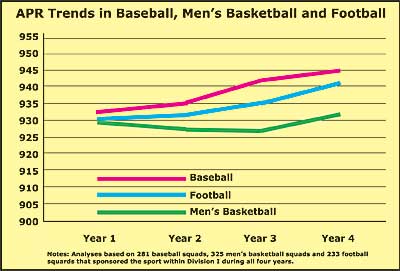NCAA News Archive - 2008
« back to 2008 | Back to NCAA News Archive Index
|
The NCAA News
The NCAA’s Academic Performance Program (APP) is creating positive behavioral change among Division I institutions, according to new four-year data released May 6.
The multi-year Academic Progress Rate (APR) data – with four years of data collection available for the first time – show upward trends in several categories, especially from 2005-06 to 2006-07. The overall APR, which measures student-athlete performance based on eligibility and retention, rose slightly, with increases in both eligibility and retention and a decrease in the number of student-athletes leaving school while academically ineligible.
The academic reform effort – and the APP in particular - was created to change the academic landscape of Division I athletics and not to be punitive. However, penalties are assessed for failing to meet the benchmark that projects to approximately 60 percent Graduation Success Rate and being unable to demonstrate measurable improvement in the APR.
Fewer teams are receiving penalties than anticipated, with 218 teams from 123 institutions falling below established benchmarks. Of the 218 teams, 113 will receive immediate penalties, while 35 will receive both an immediate penalty and a public warning for historically low performance. An additional 44 teams will receive the public warning only while 26 will face a historically based penalty restricting scholarships, recruiting and practice times.
Of the 218 penalized teams, six received conditional waivers from penalties last year, failed to meet the conditions and are penalized this year. Four of those six teams are receiving penalties for last year and this year. These teams are noted on the penalty list with an asterisk.
At one time, officials believed a much larger number of teams could be penalized this year because of the elimination of the squad size adjustment for most teams. The adjustment was in place until teams accumulated a full four years of APR data. Because of numerous factors, including mitigating circumstances and an emphasis on improvement in the waiver process, only about 3.5 percent of 6,272 teams will receive penalties. Last year, about 2 percent of teams were penalized. To see complete penalty information, click here.
NCAA President Myles Brand emphasized that the penalties were designed to change behavior and not intended to be punitive.
“We want to change the behaviors of the teams and the institutions and the athletic program so we’re all headed toward the success of student-athletes on the field and in the classroom,” Brand said.
Overall, the Division I single-year APR has risen nearly four points since data collection began. Several sports have seen increases as well. Since 2003-04, for example, baseball’s APR increased 12 points and football went up nearly 11 points.
Men’s basketball, though, has remained steady over the four year period at approximately 928 APR. After a recent drop in the sport’s APR, men’s basketball teams rebounded, improving by about four points from the 2005-06 data collection year. An NCAA panel has been assigned to address academic issues in men’s basketball and is expected to complete its work by October.
“Overall, there is much to be encouraged about with the latest data,” Brand said. “When we started four years ago, baseball and football were in serious trouble. There has been great improvement in both of those sports. We are not out of the woods, however. There are individual institutions that have seen steady decline in APR over the last four years. The situation is dire for them.”
For the first time, the average eligibility and retention rates both showed increases as well. Eligibility rates, after decreasing for the past two years since the implementation of new progress-toward-degree standards, saw the first increase since data collection began in 2003-04. The average eligibility rate for 2006-07 is 967.1, up from 965.0 in 2003-04. The average retention rate has increased steadily over the first four years of data collection, beginning at 953.6 in 2003-04 and showing a 956.7 in the most recent collection year.
Another positive trend revealed by the data is a continual decrease in the number of student-athletes earning neither the eligibility or retention points (the so-called “0-for-2”) each year. In 2003-04, 3.7 percent of the cohort earned neither point. That percentage has steadily declined, and it is now at 2.9 percent for the 2006-07 collection year. There are almost 700 fewer 0-for-2s this year than there were four years ago.
Officials attributed the improvement in APR and reduction in penalized teams to a number of factors, including the improvement plan process, which requires any institution with a team below 925 to develop a plan for improving the academic performance of student-athletes with specific goals and steps to meet them. In the first year for the improvement plan process, 157 schools submitted acceptable plans to the national office.
Institutions that do not meet the goals set forth in their improvement plans will be subject to penalties next year.
Additionally, since the reform structure was implemented four years ago, more than 4,000 student-athletes have earned a graduation bonus point for their institution by returning to their school to graduate after leaving early. While not all returned because of the bonus-point incentive, almost twice as many former student-athletes came back to earn their degree in the most recent year than in the first year of the APR program. This is another intended outcome of academic reform.
Mitigating factors, such as granting relief for teams that demonstrate measurable improvement and other criteria, also helped APRs to rise and penalties to fall.
Earlier this year, the Division I Board of Directors reiterated its commitment to academic reform in the form of a resolution, and members will continue to hold a high academic standard for all Division I student-athletes.
To discuss the APR results, visit the Double-A Zone, the official blog of the NCAA.



